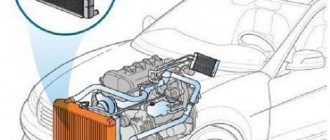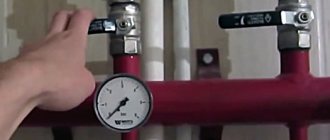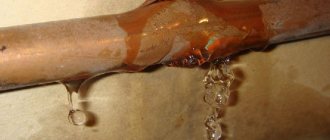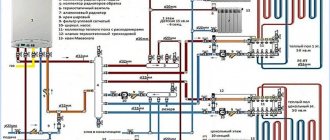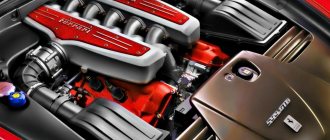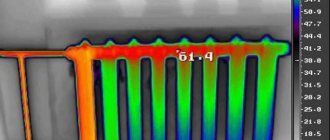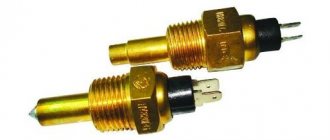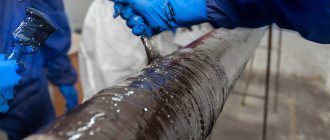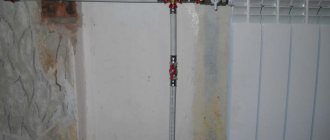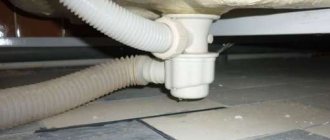Causes of damage
There are not many reasons that cause problems with radiators. All of them can be divided into two types. These are mechanical reasons and natural wear and tear, which contribute to various damages that compromise the integrity and tightness of the device. Even a small stone that accidentally flew out from under the wheels can cause a breakdown and leakage of the radiator.
But sometimes auto mechanics are faced with another factor - head-on collisions with other cars. Even a minor blow to the bumper is enough to cause a breakdown. In addition, mechanical reasons include various repair work that is done by novice car enthusiasts. This often leads to damage to important parts and components of the device.
Corrosion processes, as well as natural wear and tear, are the second group of reasons that cause radiator leaks. It must be remembered that even minor scratches or chips can very quickly turn into a source of active corrosion. If you do not pay attention to this problem in time, then as a result of the destructive process, a hole will appear through which the coolant will flow out of the system. Minor cracks are quite difficult to detect. But if you get down to business seriously, then often all such damage can still be found.
These are two groups of typical reasons that can provoke depressurization and damage to the heat exchanger and subsequently coolant leakage. In addition, there are also some troubles during operation that can cause improper circulation of antifreeze in the system.
How to find an antifreeze leak
Since coolant can leak from different places in the system, you need to know where and how to look for the problem area.
Visual inspection of pipes and clamps
By visual inspection, you can identify areas of coolant leaks. The more it leaks, the easier it is to find the leak. The procedure should begin with the pipes, since on many cars they have free access. During the inspection, you need to carefully check each hose of the cooling system, especially if the elements have been changed a long time ago.
In hard-to-reach places, you can use a mirror to check. Damaged hoses must be replaced. If no leaks are found on them, they are still worth inspecting for preventive purposes. Additionally, the clamps are subjected to visual inspection. Sometimes it happens that a coolant leak is caused by a loose fastener. In this case, tightening the clamps more tightly allows you to get rid of the problem in question.
How to seal plastic parts of a car radiator
Let's take a closer look at the adhesive method for repairing a damaged radiator using the example of using two-component industrial glue from Hosch.
To seal the radiator tank, you should prepare the following materials and tools:
- powder welding granulate and liquid component of welding adhesive;
- sandpaper;
- acetone for degreasing surfaces;
- gloves;
- cotton buds.
Stages of work:
- Preparation . Both surfaces to be bonded should be cleaned of grease and other contaminants. If traces of other glue remain on the parts, they must be completely removed. In most cases, regular acetone will do for cleaning;
- Applying glue. A minimal amount of welding adhesive is applied directly to the crack. To fill the void or in the absence of fragments of the body, the powder component of the glue is sprinkled onto the liquid base. If it is necessary to restore a large depression, gluing is recommended to be done in several stages (several layers are applied sequentially with an interval of 10 minutes). After the gap is filled with dry granulate, it must be evenly saturated with the liquid component.
- Seam processing. 10-15 minutes after completion of the work, you can begin mechanical processing of the seam using a grinding machine or fine-grained sandpaper to give the seam an aesthetic appearance.
VIDEO INSTRUCTION
Instructions - how to solder plastic parts of a car cooling radiator
To solder (weld) a plastic radiator, you should prepare the following materials and tools:
- A special construction hair dryer for heating the soldering area;
- Soldering iron with a sharp tip and precise temperature control;
- Solder for plastic - special welding rods. The markings on them must match the markings on the radiator housing. As a rule, this is “PA” - polyamide (nylon) or “PP” - polypropylene. Instead of purchased welding rods, you can use pre-prepared strips cut from a similar plastic tank;
- Acetone.
Work order:
- Degrease the repair area with acetone;
- While the soldering iron is heating up, heat the joint with a hair dryer;
- We connect the seam and gradually run a heated soldering iron along it, forming a groove equal in width to the thickness of the welding rod;
- We apply a welding rod and, heating it with a soldering iron, place it in the groove of the seam;
- We check the radiator for leaks, and then install it on the car.
The welding temperature (heating of the soldering iron) is selected in accordance with the brand of plastic. For PP this is about 250 degrees.
Selecting repair methods and adhesives
There are several ways to restore the integrity and tightness of the cooling radiator:
- Soldering. The body elements of modern car radiators, made of heat-resistant plastic, can be easily soldered using a conventional soldering iron (we will look at this process in more detail below).
- Cold welding. This is the fastest way to join plastic parts without heating. A special plastic mass, which includes polymer resins, metal filler and chemical additives, connects the bonded surfaces, forming a heat-resistant seam.
This process does not require special equipment, but such repairs cannot be called durable.
Due to the low adhesion of plastic, cold welding holds very weakly. This method allows you to only temporarily solve the problem (for example, to get to the nearest car service center).
Application of glue. If the damage is minor, special glue will help restore the seal of the case.
The following compositions have proven themselves to be excellent:
Two-component adhesive 3M DP8005 is a specialized acrylic-based composition designed for gluing difficult-to-glue plastics, polyethylene, and polypropylene.
Perfect if you need to seal a radiator crack. The adhesive joint formed by DP8005 adhesive from the 3M brand is resistant to aggressive solutions and high temperatures.
The only drawback of this glue is its high price (1300-1500 rubles per 38 gram package).
Adhesive welding for plastics Hosch. This two-component industrial adhesive effectively repairs cracks and other damage in any plastic products.
The adhesive joint can withstand high and low temperatures, as well as pressure up to 12 atmospheres, so it can be used to glue a plastic radiator without any problems.
Often the joint is stronger than the plastic being glued together. The average cost of a set of two complementary components is 1500-1700 rubles.
How to fix a leak in a radiator with sealant
The sealant is a special composition for sealing cracks and holes in the cooling system and in particular in the radiator.
There are several types of sealing agents:
- Powder. We fill the radiator when a coolant leak occurs. The simplest and most popular option among owners of domestically produced cars is mustard. Some car enthusiasts even use tobacco and other equally exotic substances for these purposes.
- Advantages. The advantages of dry products include low cost and the ability to eliminate small defects (up to 1 mm).
- Flaws. There is also a significant drawback, which is that not only leakage points are clogged, but also the radiator channels in the interior cooling and heating system.
- Liquid preparations. Preparations of this type are based on polymers with the addition of small metal particles. As a rule, such products are used to eliminate leaks in the engine block, but also partially in radiators. The operating principle is as follows: polymers cling to small roughnesses and sharp edges and envelop them.
- Advantages. The advantages of this option include the fact that the sealant is constantly present in the coolant and when it is replaced, it is removed from the cooling system.
- Flaw. Only small holes (no more than 1 mm) can be sealed with a polymer preparation;
- Modern polymer-type products. Products of this type contain special fibers. A striking example of such a substance is the sealant for radiators LAVR STOP LEAK. Thanks to the fibers, the adhesion of the particles of the product between themselves and the edges of cracks improves.
- Advantages. The main advantage of this option is that in a few minutes you can seal a hole up to 2 mm.
- Flaws. High price.
Sealant for car radiator - application
The main mistake of most car enthusiasts is that they do not know the main function of the seal. And it is simple - eliminating coolant leaks during temporary use. Therefore, it is recommended to use a sealant only in cases where it is not possible to eliminate the leak in stationary conditions or in the garage.
If a sealant was used to eliminate the cause of the leak, then, if possible, drain the coolant, flush the system and carry out a full repair of the radiator.
Driver actions when using sealing agents:
- A temperature sensor can indicate a leak from the radiator while driving. If the car is parked, then a puddle of coolant can tell us that it is necessary to check its level.
- If such a problem does arise, then turn off the engine, wait until the coolant cools down and proceed to inspect the damage. If the liquid still continues to flow, install a container under this place to collect it.
- Remember! Do not open the radiator cap of a car while the engine is running or hot, as this can cause serious burns.
- If you have a powder or liquid product on hand, then place it in the radiator according to the instructions.
Next, we start the engine for a few minutes, turn it off, and after a while we check again for leaks with the unit running. If the leak is small and the sealant was used in accordance with its instructions, then the coolant should no longer leak. In cases where the defect could not be eliminated, this may indicate to us that the hole is large. In this case, soldering is no longer necessary.
How to choose the right sealant?
To make the choice easier, a summary table with two characteristics will help: the time of clogging of holes of different diameters and the level of deposits. To evaluate the last parameter, we used the mass of the thermostat before and after applying the additive. Such testing of sealants was carried out at the Department of Internal Combustion Engines of St. Petersburg Polytechnic University.
Table
The table shows that sealants cope with microcracks successfully, even large holes are blocked within 2-10 minutes.
Methods for eliminating leaks
One of the reasons that your car radiator is constantly leaking may be a broken radiator cap. Due to old age, the radiator cap may not hold pressure, as a result of which the antifreeze in the system will constantly evaporate. This problem is often invisible to the eye and although the entire system is in order, the antifreeze disappears somewhere. You should replace the cap with a new one and check the antifreeze level after some time. If the level is normal, then the problem is solved.
Radiator fluid often disappears due to wear and tear on the rubber hoses. This is easy to notice by the traces of smudges on the hoses. Such pipes are recommended for replacement, since their repair is not advisable.
The most problematic option is when there is a leak in the radiator itself. Often in such cases, repairs do not help. If there is a large crack in the radiator, it is immediately noticeable by steam and coolant splashes. A large hole can only be repaired in a garage or auto repair shop. Copper or brass can be soldered, aluminum can only be welded with argon. You should know that such repairs are unreliable and even a service station will not give you a guarantee for more than a month.
This is interesting: OBD2 error code P0500: speed sensor malfunction
Leak sealants
These liquid consistency products are intended for sealing small leaks on the radiator, joints of pipes, the diameter of which does not exceed 1.5-2 square meters. mm. They are poured into the expansion tank or directly inside the radiator neck.
When leaking out along with antifreeze, the sealant clogs the opening of the cooling system with a polymer film, transforming during interaction with the surrounding air.
It is important to choose sealants from good manufacturers, since low-quality compounds can clog the channels over time. After using such a product, you need to clean the cooling system using special flushes, removing any deposits from the outside.
Fillinn
Claimed, Russia, ordered and supervised by PRIDE USA
Approximate price: 60 rub.
White emulsion. It looks like it's polymer. It comes loose easily and begins to act immediately after entering the tank. I was unable to heal a 1 mm hole; I managed to heal the rest, but not quickly. The level of residual deposits is high.
+ Relatively cheap composition.
- In case of serious damage, it may not save.
GUNK Radiator Sealer Super
Declared manufacturer: USA
Approximate price: 160 rub.
The thick brown emulsion works effectively and relatively quickly; holes of different diameters closed almost simultaneously. But there were a lot of deposits left after it. On old and dirty radiators this can be dangerous.
+ Works quickly and efficiently.
— Relatively high level of residual deposits.
K-Seal
Declared manufacturer: USA
Approximate price: 430 rub.
The thick brown emulsion is declared to be “long-lasting” and does not require subsequent replacement of parts. Contains copper powder that forms durable plugs. It works quite effectively, but healing of large holes is slow. But there are very few deposits.
+ Low level of residual contamination.
— The most expensive drug in our sample.
"BBF Super"
Declared manufacturer: Russia
Approximate price: 55 rub.
The white emulsion works classically - it consistently and relatively quickly closes the holes from smaller to larger. There are very few residual deposits. After opening, neat fungi of polymer plugs are visible in the place of the holes. And at the same time - the cheapest composition among those tested!
+ The best price/quality combination. Lowest sediment level.
- Not detected.
Final table (click to open full size):
Cold welding for large holes
If the radiator is broken and large cracks and holes appear, then this problem can be solved using a plastic, homogeneous or two-component product known as “Cold Welding”. This is an indispensable emergency tool; try to always have it with you in the car.
Its complete hardening time is approximately 15 minutes. In this case, it will take about 5 minutes to completely stop the leak. As the material sets, it expands. This creates the effect of a tight cork.
Our actions:
- Before using this product, you must thoroughly clean and degrease the damaged area.
- Carefully kneaded sealing compound should be spread around the hole, gradually closing it.
This is interesting: How to adjust the side door on a Gazelle?
Within an hour, the completed patch will gain the greatest strength. This is ensured by the fact that the coefficient of thermal expansion of the welding material corresponds to the metal.
Just add water
If the antifreeze leak from the cooling system is minimal, and there is nothing useful for repair in the car at all, then you can drive to a car repair shop and simply fill the leak with water:
- To prevent the engine from overheating, it is important to maintain an adequate level of coolant.
- In this case, it is better to top it up through the expansion tank.
- Water can only be added to the radiator neck when the power unit is cold.
In this case, it is recommended to use a distillate; in this case, scale formation inside the system will be minimal. But if you don’t have this luxury either, then ordinary water will also do. While driving the car, it is important to monitor the fluid level inside the radiator system.
"Folk" way
All experienced car enthusiasts know this method. It is known that ordinary powdered mustard “clogs” all small cracks. It is well diluted with water. While moving in suspension, particles of mustard powder, entering the leak cavities, accumulate, stopping it. Automotive stores sell special tablets and powders whose action is based on this principle. They often include mustard. There is no worse quality powder purchased at the nearest shopping center.
You cannot operate a car with mustard in the cooling system for a long time. It is necessary to eliminate the leak as quickly as possible using the standard method (welding, soldering). After using mustard powder, the cooling system should be flushed, as mustard can clog the narrow channels of the system.
Instead of mustard, you can use ground pepper, flour (about 10 grams) and even two raw eggs. The effectiveness of such a kitchen will be less than mustard.
Types of leaks and ways to eliminate them
There are several main types of leaks:
- crack in the body of a sectional, tubular or panel radiator;
- violation of the tightness of the seam connecting the sections of the battery;
- leakage in the radiator piping area;
- leakage of pipes.
Leak on radiator piping
Using a clamp and rubber gasket
Before you fix a leak in the heating battery. formed at the connection point of the coolant supply or return, you need to prepare some tools, these are:
- aluminum clamp;
- rubber gasket;
- wire;
- pliers.
Repairing leaks using FUM tape
According to OKPD, individual heating system repairs can be carried out using a special FUM tape.
Violation of the tightness of a sectional, panel or tubular radiator
In most cases, a damaged radiator will need to be replaced.
Application of cold welding
Plate adhesive is able to eliminate any types of cracks and breakdowns and restore the tightness of the heating battery. The glue is resistant to moisture and high temperatures. Its use is considered one of the most reliable ways to eliminate leaks in a heating system and is often used as an emergency method during circuit accidents.
Removing cracks in the cylinder block and cylinder head
Engine blocks and heads consist of various metal alloys. Technologies that exist today often make it possible to restore damaged elements. Next, we will look at ways to fix the breakdown and answer the question of how to remove cracks in the cylinder block and repair cracks in the cylinder head. In some cases, you can repair cracks yourself.
One of the most widely used methods for eliminating cracks in the cylinder block and cylinder head is sealing defects in silumin and cast iron blocks using welding.
Welding can be either electric or “cold”. Cold welding means sealing cracks with various polymer-based materials. Almost all cracks can be welded using the first or second method, except for cracks in the area of the valve seat, cylinder walls, as well as those surfaces where the cylinder head and cylinder head adhere.
Application of cold welding
In “field” conditions, it can be useful if the damage is clearly visible and does not require dismantling the radiator. If the repair is carried out “at home”, then it is better to remove the product. For this:
- drain the coolant from the cooled engine into a previously prepared container through special holes in the cylinder block and the lower part of the radiator (you can loosen the pipe clamp);
- disconnect the electrical connectors from the temperature and fan switch sensors;
- loosen the clamps and remove the hoses and pipes suitable for the radiator;
- unscrew the screws securing the product and pull it out (in some models, together with the fan).
“Cold” welding is a product consisting of adhesive-sealant and metal powder. The composition can be ready for use or sold in the form of separate components that must be mixed before use to obtain a homogeneous mass. Process of using the product:
- clean the area around the defective hole or crack with sandpaper;
- degrease the problem area with gasoline or acetone;
- mix the composition if it is made of separate components or knead it with your hands according to the instructions (then you can paint this place);
- wait until it sets;
- Complete hardening occurs depending on the brand of “cold” welding and takes 1-24 hours.
Next, install the radiator in place, at the same time cleaning it from dust and insects that clog the honeycombs from the outside. The main advantage when using such compositions is that they have the same coefficient of thermal expansion as metal. That is, the patch may not allow coolant to pass through for several years.
What is the danger of a constant coolant leak?
If the cooling radiator is leaking, you need to know what to do or which specialists to contact to fix such a problem. Constant leakage can lead to negative and even dangerous situations:
- engine overheating and further failure;
- changing the configuration of the cooling system and violating the integrity of the material used as a gasket;
- engine jamming, which will entail costly and time-consuming repairs;
- thermal burns that can occur when a crack in the radiator ruptures and hot liquid flows out in a fountain.
Why is a radiator needed and why its leaks are dangerous? Now that we have figured out, it’s time to move on to the main issue - considering ways to eliminate leaks and return the cooling system to tightness.
This is interesting: Description, properties and application of BF brand adhesives (video)
Causes of leaks
There are not many of them and they are all conditionally divided into several groups, which are worth considering in more detail:
- Natural wear and tear. First of all, this refers to corrosion processes that, over time, destroy thin radiator tubes and form leaks. But sometimes the cause of failure of the structural elements of the radiator can be small scratches, dents, chips, which turn into corrosion spots.
- Mechanical damage. They usually occur after a head-on collision. Even a small defect in the bumper or decorative grille can be enough to cause the radiator to leak. The second point is sloppy installation work, during which the honeycombs of the product and its tubes were carelessly damaged.
- Loosening of fastenings. It can happen over time due to vibrations or during repairs, when an inexperienced car enthusiast simply forgets to properly tighten one or another clamp on the pipe.
- Wear or defect of the expansion tank (radiator) cap. In this case, the pressure created in the CO will push the antifreeze through the bad cap. This can be determined by the traces of coolant around the filler neck.
All of the above reasons lead to the formation of a coolant leak. Moreover, in some cases (for example, with corrosion), it is quite difficult to detect it right away. In such a situation, you need to drain the antifreeze and remove the radiator. Further:
- Close all its openings with suitable plugs.
- Place the product in a large container of water: escaping air bubbles will indicate the location of the leak.
Article on the topic: Spark plug: what role it plays, what it consists of
There is another method for locating the leak if the method described above did not help. To do this, you will need a special kit that includes an introductory gun, an ultraviolet lamp and a fluorescent additive. Add it to the cooling system and check all CO elements, including the radiator, with a lamp: leaks will glow. But all this can be checked under stationary conditions, but what to do if the radiator leaks while on the road?
Assessing the extent of radiator damage
It is customary to install the radiator itself in the engine compartment, or rather in its front part. This is how it is possible to create the effect of blowing with a counter flow of air while the vehicle is moving. The disadvantage of a car heat exchanger is its fragility. This device is often called the most vulnerable part of any car.
Even if the slightest impact occurs, the likelihood of mechanical damage to the spare part in question is quite high. Heat exchangers whose water tanks are made of plastic break down especially often. Therefore, when deciding how to repair a radiator, you need to focus primarily on your capabilities. Carefully study all the methods presented above and try to figure out which method will be the most convenient and simplest from a practical point of view.
It is also important to first assess the extent of the damage. If it is strong enough, it is recommended to focus on direct soldering
This way you can deal with really large cracks that cannot be fixed with ordinary glue. If the crack is not the largest, cold welding type putty is quite suitable. Glue will be the optimal solution for restoring small cracks.
If you are not sure that you know how to seal a car’s cooling system, it is better to focus on repairing the system at a car service center. In addition, you won’t have to spend too much money on restoration work carried out by a mechanic, because the process itself is not considered difficult.
This is interesting: Unusual use of a glue gun - what can be made from hot glue
Conclusions: the radiator is leaking, what to do to solve the problem
Above, we looked at the options for what could be the cause of a cooling radiator leak and how to eliminate it. But as car service experts say, it’s better to avoid these problems. To do this, it is recommended to fill the cooling system with high-quality antifreeze and not skimp on additives that extend the service life of the unit. If you follow these recommendations, you will not have to worry about how to fix a radiator leak, because it will work for the period stated by the manufacturer. Damage that appears after the end of its service life cannot be repaired by simply replacing the entire radiator.
If this problem occurs, the top of the radiator is leaking, or a crack is found elsewhere, visit one of our Oiler auto repair shops. They are located in different parts of Kyiv, each with convenient access. Our technicians will quickly determine why the cooling radiator is leaking and fix the problem. In order not to lose personal time, it is recommended to pre-register for a visit to the car service. This can be done on the company's website or by telephone. Our advantage is that we solve the problem on the day you contact us. Therefore, using sealants, we will quickly eliminate a small radiator leak; we will also carry out repairs on the day of your call if it is necessary to repair large damages by soldering.
How to seal a car radiator
Now let's talk about how to seal the radiator and what glue is best suited for this. Thus, one of the best options is considered to be the two-component adhesive 3M DP 8805. The basis of its composition is acrylic, which makes it possible to use the composition for working with difficult-to-glue materials:
- the main advantages of such glue are the ability to create a sufficiently strong and reliable seam that will not lose its original shape when exposed to high temperatures;
- The disadvantage is the rather high cost.
Special welding adhesives are also a good option. They are designed for quick and, most importantly, effective elimination of defects on plastic surfaces. Adhesive joints after such compositions withstand not only high but also low temperatures. In addition, they are not afraid of high atmospheric pressure.
To avoid making a mistake in your choice, we recommend purchasing the required adhesive from a certified automotive store.
Radiator repair methods
- You can also use a gas torch for soldering.
To quickly eliminate leaks from broken radiator tubes. You can mute them. To do this, bend both torn edges of each tube and clamp them with pliers. This method is suitable if no more than 5 tubes are broken. Such repairs are justified if the radiator is aluminum and you cannot solder it.
- When the radiator is aluminum and its plastic tank is broken. If the length of the hole is not too different from its width, a rubber plug will help to seal the hole. You need to do it like this: A plug is cut out of rubber at least 1 cm thick in the shape of the hole. A hole with a diameter of about 5 mm is made in the center. An M6 screw is inserted into the hole, onto which the corresponding nut is screwed. The plug is inserted into the hole. The screw is tightened until the plug compressed by it and the nut, expanding, loses its mobility. After this, the plug will reliably plug the hole. You can add antifreeze. If the screw head or nut falls into the hole and the plug does not expand enough, place a washer under them. After adding antifreeze, an air lock usually forms in the system. It is removed by undocking the top point of the car's cooling system.
- If the copper radiator pipe has a crack near the tank.
Remember that when buying such compounds, you risk further harming the engine cooling system
Clean, degrease and solder it thoroughly by pouring a thick layer of solder on it. This type of repair is quite acceptable.
- When the plastic pipe has a crack near the tank. Order a turner to make a tube with an outer diameter equal to the inner diameter of the pipe, 3-4 cm long. Remove the piece of pipe from the tank, clean, degrease and dry it from the inside. Glue a tube made by a turner into it onto the liquid glass so that half of its length remains outside. Dry the structure and glue it into the radiator tank. This must be done with the same glue. It is better to strengthen the joint on top with a textile bandage on liquid glass.
You need to make an oil cooler taking into account what it is made of. Its repair begins with draining the oil from it. Cork is also made. You just need to make it from oil-resistant rubber, since other oil will quickly render it unusable. Before soldering, the oil radiator should be thoroughly rinsed inside and the oil removed from the outside. It’s better not to repair the oil radiator, but to buy a new one.
How to find a crack
The following methods are used to identify cracks:
- ultrasonic detection method;
- use of magnetically sensitive equipment;
- pneumatic crimping method;
- searching for cracks using hydraulic control;
In practice, crack detection in many car repair shops is carried out by pumping air or water into the faulty engine element. In the case of air, the part is additionally immersed in a bath and defects are found by bubbles. If water is pumped into the element, then the need for immersion is eliminated, since cracks are diagnosed by liquid seepage.
To determine the exact boundaries of the crack, a pair of magnets are attached to both sides of the split, and the space between the magnets is filled with special conductive filings. The presence of a crack will cause the magnetic field lines to break, causing sawdust to partially cluster on the crack surface. This method allows you to clearly identify a crack in the cylinder block or cylinder head.
How to accurately determine the location of a radiator leak
Before you start repairing the radiator, you need to determine the nature and location of the malfunction itself. Almost all external malfunctions of the radiator (except for ordinary contamination) involve a violation of its tightness, which means there must be a coolant leak.
The intensity of liquid leakage from the radiator may vary, and at the initial stage it is not visually noticeable, but a rapid decrease in the liquid level in the tank is noticed almost immediately. After all, a decrease in the level of antifreeze or antifreeze leads to overheating of the engine, which is immediately signaled by a special temperature sensor on the driver’s instrument panel.
To accurately determine the location of a fluid leak, you can use two methods. In this case, you will need to completely drain the coolant from the radiator, and disconnect the radiator itself, remove it from the car and rinse thoroughly.
Also remove, empty and clean the radiator, but with all inlets plugged, completely immerse it in a suitable container of water. Air bubbles will be seen escaping from holes in damaged areas. If air does not come out, create excess pressure in the radiator using a pump or compressor.
Leak detection
Most often, the location of a coolant leak is identified as follows. Remove the radiator and close the openings of the pipes. Next, the radiator is placed in a tank of water, and excess pressure is pumped up with a compressor or pump. After this, it is necessary to conduct a visual inspection, which will immediately show where the air bubbles are coming from.
If you still cannot accurately determine the location of the leak, then you need to use special devices. They consist of a fluorescent additive, a special gun for introducing the additive into the cooling system and a lamp emitting ultraviolet rays, in the light of which the antifreeze flowing from the radiator will glow. The disadvantage of this method is its high cost, and there is no point in purchasing it for your own needs. It will be easier and cheaper to go to a car service center.
To prevent the radiator from leaking, you need to monitor the condition and level of antifreeze, avoid oil penetration into the seals, and avoid excessive pressure in the system.
Soldering aluminum radiators
Don’t rush to take up the soldering iron - you can always do it in time. First you need to study the scale of the tragedy and choose the most appropriate repair option.
- you can simply pour solder into a place with a small defect;
- a breakdown with an impressive size will have to be covered with a patch and soldered along the entire circuit.
Next we will describe in detail how to solder the radiator. If you follow these instructions, even a person without relevant experience will definitely succeed.
We dismantle the device, drain the liquid from it, disconnect the pipes, bolts and remove the assembly. At the leak site, we remove dirt, clean off dust and dry it. We apply rosin to a dry and clean surface, but it is better to use soldering acid. For an aluminum radiator, it is important to use active flux or aluminum solder. This is due to the oxide film that forms instantly
It can disrupt the entire repair process. A leak may form on the tube - this situation is not uncommon. In this case, you will need to warm up the soldering area and remove the tube. Then soldering is carried out or the tube is replaced with a new one if the damage is large. It is not always possible to reach the tube so easily with a soldering iron. In this case, you will need to insert a heated rod into the damaged tube. The temperature will make the solder soft, allowing you to remove the tube without any problems.
Since we are talking about soldering radiators, it is worth giving advice on such repairs to copper and brass structures. To repair such parts, you need to use a special soldering iron that is designed to work with such materials. The power of such a soldering iron must exceed 250 W. The work is performed according to the following scheme:
- the surface is also cleaned and dried;
- the material warms up;
- rosin is applied as evenly as possible;
- Solder is also applied in an even layer.
How to seal a leak in a heating pipe, radiator, between sections
The method for eliminating a leak in a heating system largely depends on the location where the leak appeared. The leak could be:
- on a single pipe;
- at the junction of pipes and radiators, pipes and fittings (adapters, tees, etc.);
- between battery sections;
- right on the radiator.
Depending on the scale of the disaster (what else can we call it?), the actions differ. If these are just the first signs - a few drops per hour or a very thin trickle - you can try to eliminate it yourself, using improvised or purchased means.
You can fix radiator and pipe leaks with your own hands. The main thing is that it flows lightly
If the flow is strong, the first thing for residents of high-rise buildings is to call an emergency team. The next step is common to everyone: turn off the coolant supply. There are several options:
- The radiator is leaking. At the same time, there are shut-off valves at its inlet and outlet. Then just close the taps. For owners of individual heating, everything is simple, but for subscribers of centralized heating there are several situations. The radiator is installed with a bypass, then when the device is turned off in your apartment, nothing happens to the common riser, the heating continues to work. No problems, just do the repairs in peace.
- There is no bypass. Then you need to either inform your neighbors and (or) the DEZ, Housing Office, etc. and then start fixing the problem.
We really don’t like to call emergency lights and often try to fix everything ourselves. There is a chance to fix the leak with your own hands if the leak is not “within the radius”. Then we'll try to localize the problem.
The difference between a new and used pipe is obvious
Possibility of repairs
If the cooling radiator leaks with a small crack, you can fix the problem yourself. But if a leak occurs at the junction of the plastic pipe and the radiator itself, then such a malfunction cannot be eliminated. Temporarily, if it is impossible to quickly purchase a new radiator, you can use sealant or epoxy glue.
If there are several or one small crack through which antifreeze flows a few drops at a time, then you can quickly achieve the result with a special sealant. It should be poured into the cooling system. The components are substances that heal small cracks and create a tight seal of the radiator housing. After this, you can drive a car, since it takes some time for the sealant to take effect, after which the leak should stop.
Many car owners do not know what to do if the radiator leaks due to corrosion. In this case, sealants are useless, and the radiator can only be repaired by soldering. This is a rather complex process, and can only be done with extensive experience and special equipment. It is also difficult to repair a radiator with mechanical damage. Sometimes argon welding is used for this.
When doing independent work with a radiator for the first time, you need to prepare to redo the work. It is impossible to immediately detect all the cracks on the radiator by looking at it. This can only be seen when installing it and starting the engine. If after 30 minutes of idling no leakage appears, this means that a good result has been achieved. If a leak appears, work should be started from the very beginning.
